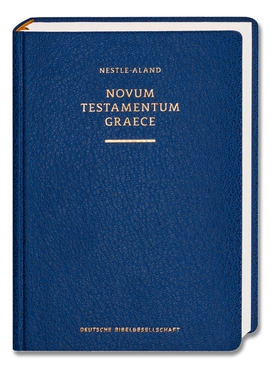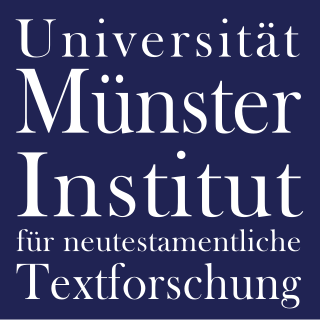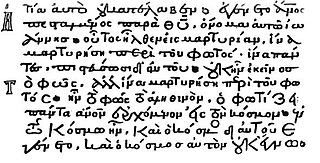The following articles contain lists of New Testament manuscripts:
In textual criticism of the New Testament, the Alexandrian text-type is one of the main text types. It is the text type favored by the majority of modern textual critics and it is the basis for most modern Bible translations.

Textus Receptus refers to the succession of printed editions of the Greek New Testament from Erasmus's Novum Instrumentum omne (1516) to the 1633 Elzevir edition.

Novum Testamentum Graece is a critical edition of the New Testament in its original Koine Greek, forming the basis of most modern Bible translations and biblical criticism. It is also known as the Nestle–Aland edition after its most influential editors, Eberhard Nestle and Kurt Aland. The text, edited by the Institute for New Testament Textual Research, is currently in its 28th edition, abbreviated NA28.
A biblical manuscript is any handwritten copy of a portion of the text of the Bible. Biblical manuscripts vary in size from tiny scrolls containing individual verses of the Jewish scriptures to huge polyglot codices containing both the Hebrew Bible (Tanakh) and the New Testament, as well as extracanonical works.

The Institute for New Testament Textual Research at the University of Münster, Westphalia, Germany, is to research the textual history of the New Testament and to reconstruct its Greek initial text on the basis of the entire manuscript tradition, the early translations and patristic citations; furthermore the preparation of an Editio Critica Maior based on the entire tradition of the New Testament in Greek manuscripts, early versions and New Testament quotations in ancient Christian literature. Under Kurt Aland's supervision, the INTF collected almost the entire material that was needed. The manuscript count in 1950 was 4250, in 1983, 5460, and in 2017 approximately 5800 manuscripts.

Minuscule 2814, Aν20, formerly labelled as 1rK in all catalogues, but subsequently renumbered as a 2814 by Aland, is a Greek minuscule manuscript of the New Testament, dated palaeographically to the 12th century.
Minuscule 639. It is a Greek minuscule manuscript of the New Testament, on a parchment. It is dated palaeographically to the 11th century. The manuscript is lacunose. Formerly it was labeled by 192a and 246p.
Minuscule 42, α107, known as Codex Maedicaeus is a Greek minuscule manuscript of the New Testament on parchment. Palaeographically it has been assigned to the 11th century. It has marginalia.
Minuscule 110, α 204, is a Greek minuscule manuscript of the New Testament on parchment. Using the study of comparative writing styles (palaeography), it has been assigned to the 12th century. It has complex contents with full marginal notations.
Minuscule 436, α 172, is a Greek minuscule manuscript of the New Testament, on parchment. Palaeographically it has been assigned to the 11th or 12th century. Formerly it was labelled by 73a and 80p.
Minuscule 442 (in the Gregory-Aland numbering), O18 (in the Soden numbering), is a Greek minuscule manuscript of the New Testament, on parchment. Palaeographically it has been assigned to the 12 or 13th century. Formerly it was assigned by 68a and 73p. It shared all these designations with Minuscule 441, with which it now comprises a single codex.
Minuscule 443, ε 270, is a Greek minuscule manuscript of the New Testament, on parchment. Palaeographically it has been assigned to the 12th century. It has marginalia.

Minuscule 444, δ 551, is a Greek minuscule manuscript of the New Testament, on parchment. Palaeographically it has been assigned to the 15th century.

Minuscule 447, ε 507, is a Greek minuscule manuscript of the New Testament, on parchment. Palaeographically it has been assigned to the 15th century.
Minuscule 449, ε 330, is a Greek minuscule manuscript of the New Testament, on parchment. Palaeographically it has been assigned to the 13th century.

A New Testament minuscule is a copy of a portion of the New Testament written in a small, cursive Greek script. Most of the minuscules are still written on parchment. Paper was used since the 12th century.

The list of New Testament Minuscules ordered by Gregory-Aland index number is divided into three sections:
Minuscule 893, Νμ2, is a 12th-century Greek minuscule manuscript of the New Testament on paper, with a commentary. It was prepared for liturgical use.